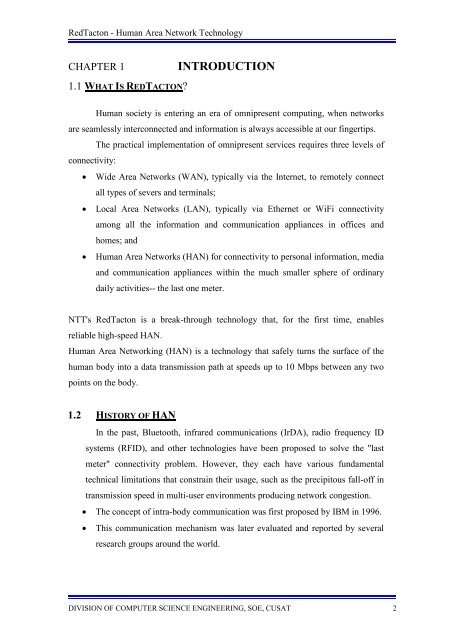REDTACTON - DSpace at CUSAT
REDTACTON - DSpace at CUSAT
REDTACTON - DSpace at CUSAT
Create successful ePaper yourself
Turn your PDF publications into a flip-book with our unique Google optimized e-Paper software.
RedTacton - Human Area Network Technology<br />
CHAPTER 1 INTRODUCTION<br />
1.1 WHAT IS <strong>REDTACTON</strong>?<br />
Human society is entering an era of omnipresent computing, when networks<br />
are seamlessly interconnected and inform<strong>at</strong>ion is always accessible <strong>at</strong> our fingertips.<br />
connectivity:<br />
The practical implement<strong>at</strong>ion of omnipresent services requires three levels of<br />
• Wide Area Networks (WAN), typically via the Internet, to remotely connect<br />
all types of severs and terminals;<br />
• Local Area Networks (LAN), typically via Ethernet or WiFi connectivity<br />
among all the inform<strong>at</strong>ion and communic<strong>at</strong>ion appliances in offices and<br />
homes; and<br />
• Human Area Networks (HAN) for connectivity to personal inform<strong>at</strong>ion, media<br />
and communic<strong>at</strong>ion appliances within the much smaller sphere of ordinary<br />
daily activities-- the last one meter.<br />
NTT's RedTacton is a break-through technology th<strong>at</strong>, for the first time, enables<br />
reliable high-speed HAN.<br />
Human Area Networking (HAN) is a technology th<strong>at</strong> safely turns the surface of the<br />
human body into a d<strong>at</strong>a transmission p<strong>at</strong>h <strong>at</strong> speeds up to 10 Mbps between any two<br />
points on the body.<br />
1.2 HISTORY OF HAN<br />
In the past, Bluetooth, infrared communic<strong>at</strong>ions (IrDA), radio frequency ID<br />
systems (RFID), and other technologies have been proposed to solve the "last<br />
meter" connectivity problem. However, they each have various fundamental<br />
technical limit<strong>at</strong>ions th<strong>at</strong> constrain their usage, such as the precipitous fall-off in<br />
transmission speed in multi-user environments producing network congestion.<br />
• The concept of intra-body communic<strong>at</strong>ion was first proposed by IBM in 1996.<br />
• This communic<strong>at</strong>ion mechanism was l<strong>at</strong>er evalu<strong>at</strong>ed and reported by several<br />
research groups around the world.<br />
DIVISION OF COMPUTER SCIENCE ENGINEERING, SOE, <strong>CUSAT</strong> 2
















